- Cavaletti can help burn off mental and physical energy when a long walk is not an option.
- If you have little space and time, these "little horse" moves may be just the thing for you.
- Cavaletti strengthens muscles, challenge the brain, and helps build the dog-owner bond.
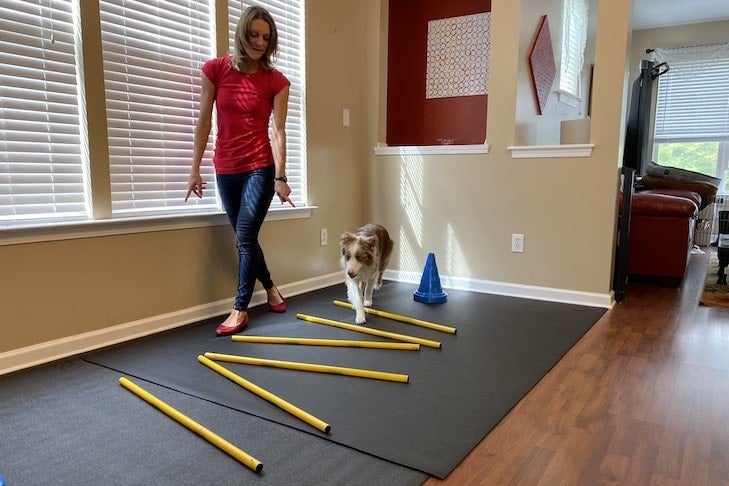
You may have an incredible canine conditioning secret tucked away in your garage, closet, or kitchen. Its name—cavaletti—sounds like something that should come with marinara sauce and meatballs. In reality, it’s an Italian word meaning “little horse.” Equine trainers developed cavaletti exercises, such as variations of stepping over poles, for horse conditioning.
This tool migrated into the dog world for physical therapy and dog sport training. The equipment consists of poles set close to the ground. It can be constructed using PVC piping and cones, foam pool noodles, low agility jumps, or even golf clubs balanced on tennis shoes. There are also inexpensive cavaletti sets you can buy online.
Benefits of Cavaletti
Cavaletti adds a dose variety to canine conditioning work. By changing the configurations of the poles, you can work distinct sets of muscles. The spacing and the height of the poles motivate the dog to move in different ways. There are seemingly endless layouts, and the variety helps improve body awareness, rhythm, stamina, flexibility, and strength.
“Dogs use very little of their available joint range of motion with certain gaits, such as walking and trotting,” says Darryl Millis, DVM, professor of orthopedic surgery and director of the CARES Center for Veterinary Sports Medicine at the University of Tennessee College of Veterinary Medicine. “A dog stepping over obstacles, as in cavaletti, increases flexion of certain joints. This encourages a greater active range of motion and muscle strengthening through a greater range. In addition, body awareness and joint position sense are challenged by stepping over obstacles, especially if there are different rail heights and configurations.”
Cavaletti spaced closer together or in weaving patterns refine a dog’s ability to collect or shorten their stride. This skill makes it easier for a dog to change direction or reduce speed. If a dog can quickly collect, they can effectively shift their path on an agility course, for example. Also, cavaletti can be a vital part of establishing a dog’s physical readiness and coordination for jumping.
Cavaletti Configurations
Cavaletti set up in a straight line can boost speed by lengthening a dog’s stride. Gradually adding space between the poles helps lengthen the stride because the dog must step farther to avoid the poles. Speed is highly valuable to sports and working dogs—think law enforcement K-9s chasing criminals, or agility dogs. For a more powerful dock diver, cavaletti can amplify the sprint before the jump.
“These exercises are great for dogs with orthopedic or neurologic conditions, or recovering from various injuries or surgeries, but also for athletes or working dogs to keep the body in functional condition,” Millis says.
Trainers use several configurations, aimed at strengthening different body parts. You can start by picking one or more of these four exercises to complement your dog’s fitness regimen three to five days a week. For the first four exercises, set the poles very low, about hock (ankle) height or lower. Strive for three to five sets of three to 10 repetitions.
Pick Up Sticks Setup

This variation is named after the game, which originated in 1800s China. It sets out a pile of small sticks in random order. Place your poles in a random pattern and ensure there is enough space between the poles for your dog to navigate while walking or trotting. The poles should be two inches high or lower. For smaller dogs or for a fast set up, set the poles on the ground!
What to do: Walk with your dog and go down the row of poles and then back one rep. For an added challenge, have your dog wrap (walk around) a cone set several feet away from the first and last stick.
Square Setup
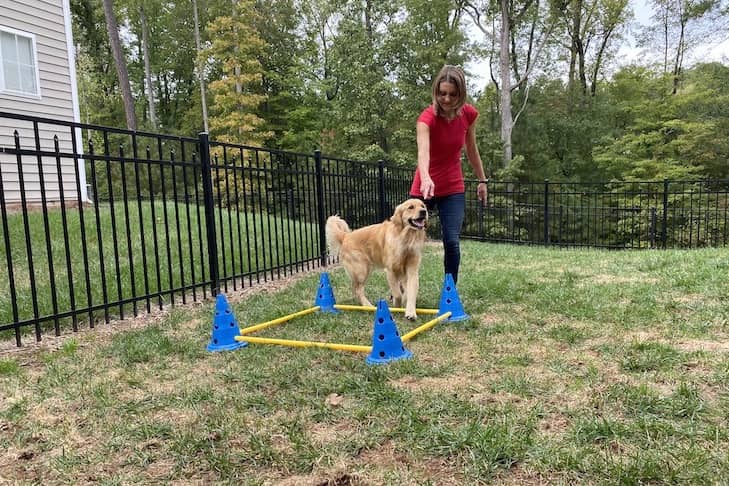
Place four poles and four cones into a connecting square.
What to do: Guide your dog with your body motion in figure-eight walking patterns around the cones by stepping over the poles. Vary your figure-eight pattern to crosswise cones and adjacent cones. Consider four cone wraps to be one repetition.
Serpentine Setup
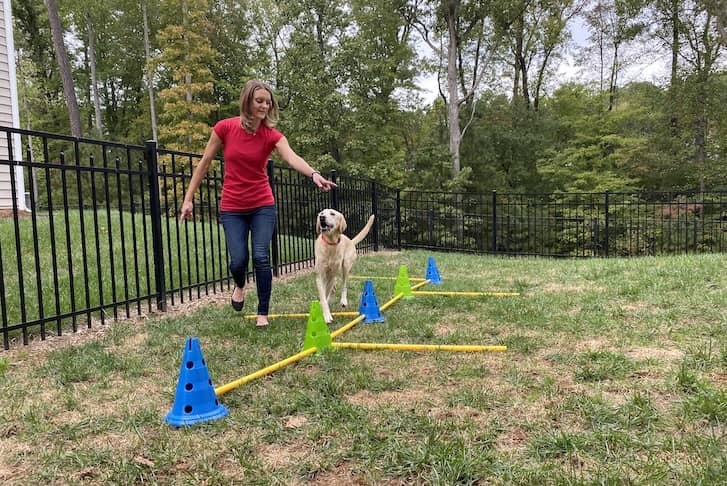
First, connect three to five poles between four cones to form a straight line. Then take an even number of poles and place them on alternating sides of the cones. If your dog were to walk over all the poles, they would walk a serpentine or zig-zag pattern.
What to do: Walk beside your dog and indicate the weaving motion with arm signals. Your dog will weave between the cones while stepping over every pole. Down and back through the serpentine is one rep.
High Stepping Setup
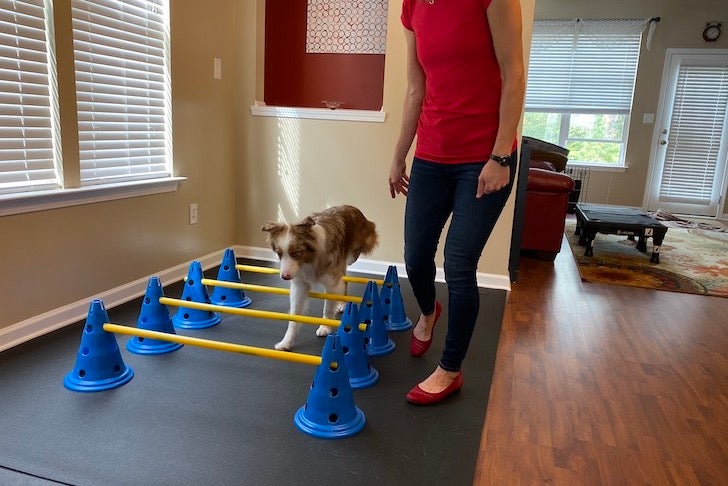
Set up four or six poles at your dog’s elbow height—or lower—and about 12 inches apart.
What to do: Walk next to your dog and encourage them to walk through the high poles with control. Turn around and repeat to complete one rep.
Stretching a Stride Setup
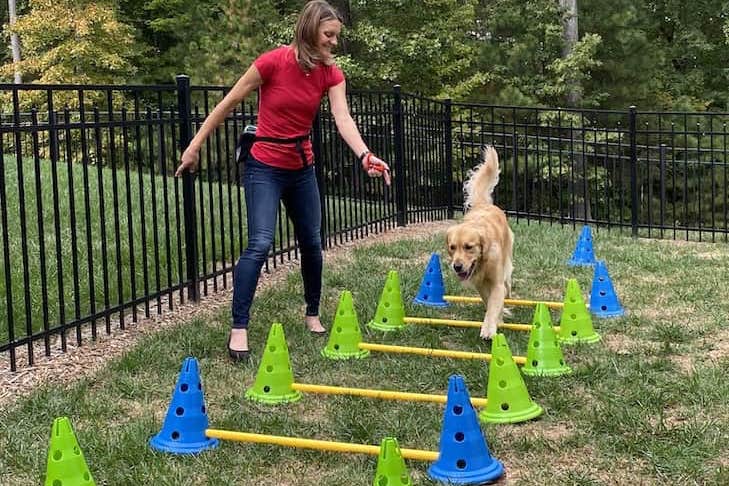
Place four or six poles between two end cones. The distance between each pole should be the dog’s height at the withers (highest point of the shoulders). If your dog has a long back, you will use the length of their spine—excluding the tail—instead of the withers measurement.
What to do: Walk next to your dog to encourage them to walk or trot over the poles. You want your dog to trot with one forelimb and one hindlimb stepping between poles. To lengthen your dog’s stride, increase the distance between the poles by just one inch! As they amplify their stride over time, you will add another inch between the poles and so on.
Cavaletti Safety
Ensure that the ground surface is safe and has some texture for your dog. Be mindful that no jagged edges—for example, on home-cut PVC piping—exist that could snag your dog’s paw if they misstep.
Before and after the cavaletti session, warm-up and cool down with a walk or puppy pushups—sit, down, sit, stand, down, stand, and so on.
Just as you’d check with your physician before pursuing a new exercise routine, consult your veterinarian before having your dog participate in new physical activities. If you notice any discomfort during training, cease the workout and contact your vet.
This column first appeared in the January/February 2020 issue of AKC Family Dog magazine.
The AKC is here to help owners with questions and concerns about COVID-19 and dogs. Find answers to your questions, plus at-home activity ideas, training tips, educational resources, and more on our Coping With COVID-19 hub.



